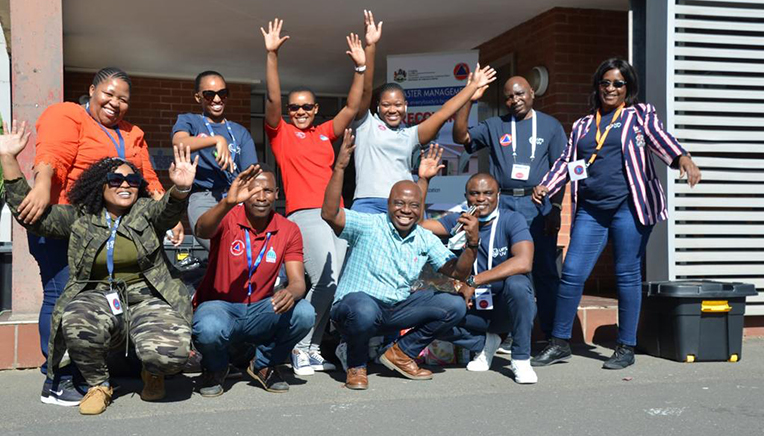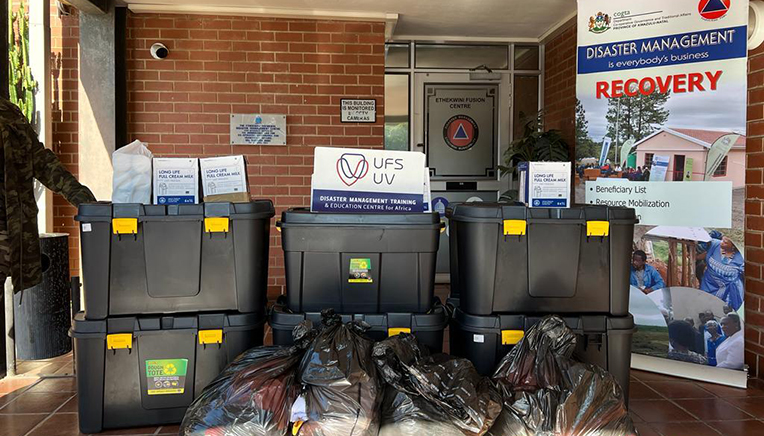23 June 2022
|
Story Dr Olivia Kunguma
|
Photo Supplie
 Dr Olivia Kunguma is a lecturer in the Disaster Management Training and Education Centre for Africa (DiMTEC) at UFS.
Dr Olivia Kunguma is a lecturer in the Disaster Management Training and Education Centre for Africa (DiMTEC) at UFS.
Opinion article by Dr Olivia Kunguma, Disaster Management Training and Education Centre for Africa, University of the Free State.
On 13 April 2022, the
National Disaster Management Centre (NDMC) 'classified' the KwaZulu-Natal (KZN) floods as a provincial disaster in terms of Section 23 of the Disaster Management Act, 57 of 2002 (DMA). Following the classification, the KZN provincial
government 'declared' a provincial state of disaster in terms of Section 41 of the DMA. Subsequent to this declaration and after considering reports from other provinces such as Eastern Cape and North West that were also affected by floods, on 18
April 2022, the disaster was reclassified. Following a consultation with the Cabinet, the Minister of Cooperative Governance and Traditional Affairs,
Dr Nkosazana Dlamini-Zuma declared a national state of disaster. The national state of disaster was
in terms of Section 27(1) and Section 23(6)(a)(b), which states that a disaster is a national disaster if it affects more than one province or if a single province is unable to deal with the disaster effectively. Another primary purpose of a national
declaration was because the existing legislation and contingency arrangements of the affected state organs were insufficient to handle the provincial disaster and a need to activate other extraordinary measures as and when required. Also, the provincial
disaster declaration was insufficient, given the widespread magnitude of the KZN floods. Since Durban has a port on which the entire nation and the Southern African region depend, the disaster had implications beyond the province. The Department of
Cooperative Governance (DCOG) is the leading government department coordinating all stakeholders and intervention measures to address the effects of the disaster. The department is following a three-phased approach to support the affected provinces.
The approach includes; immediate humanitarian relief, stabilisation and recovery, and rehabilitation and reconstruction.
Before the flooding disaster the KZN community was already vulnerable to xenophobic attacks, the COVID-19 pandemic, and civil unrest. The flooding disaster exacerbated the communities’ vulnerability and had a severe social, economic and environmental
impact. At least 461 people lost their lives, about 874 companies were affected, 40 000 people were displaced, more than 40 people were reported missing, and damage to infrastructure was estimated at more than R20 billion. Mindful of all these challenges,
local and international organisations and local communities extended a helping hand to those affected by the disaster.
South Africa’s general response to disasters
As stated earlier, South Africa has been exposed to various hazards, some declared disasters by the government. In the past decade alone, xenophobic attacks on foreign nationals were declared a disaster in 2015; in 2018-2020 a drought was declared a disaster.
In 2021, riots and looting in KZN were declared a disaster. Now the 2022 flooding has been declared a disaster. The occurrence and effect of hazards and the capabilities of the people affected to respond determines the need for a disaster declaration.
Once a disaster has been declared, the necessary resources will be released. The point in question here is, “Is South Africa’s response to disasters adequate, timely and enough to assist affected communities?” The answer is the response
is 'fair'. The fact that there is good disaster legislation that guides the process makes it a positive starting point. The challenge where timeliness is affected is the lengthy process of declaring the disaster so that the response can take place
quickly. The response to xenophobic attacks was slow and inadequate because the government did not know how to classify the hazard. The response to the KZN looting and recent KZN flooding was also slow and inadequate, leading to significant impacts.
To improve the response to disasters the proactive involvement of all stakeholders is needed, where all organs of state have sufficient resources and are prepared to respond to hazards in their custodianship, for example, drought, is the responsibility
of the Department of Agriculture.
Procedures for handling donations and relief
Organisations and individuals come together to respond to and assist victims of the disaster. With all volunteers coming together, the duplication of efforts is anticipated. According to the South African National Disaster Management Framework (NDMF)
of 2005, the Disaster Management Centres must establish appropriate protocols to clarify procedures for requesting assistance and discourage ad hoc and unsolicited appeals for relief. Any possibilities of duplication are mitigated by establishing
a Joint Operating Committee (JOC). Activating a JOC helps standardise reporting protocols and improve the coordination of interventions. Specific organisations form part of the JOC with allocated roles and responsibilities based on the disaster. For
example, the Department of Social Development is responsible for conducting needs assessments and distributing relief items.
Furthermore, each stakeholder forming part of the JOC should implement the existing contingency or response plans and establish standard operating protocols or procedures (SOPs) for coordinating response and recovery operations as per their mandate. Some
organisations do have SOPs, response or contingency plans, but due to the magnitude of the disaster, they could not be used effectively. The NDMF mandates the development of Regulations for the Practice and Management of Relief Operations. The regulations
must be gazetted and must include relief standards and the duration of relief efforts. A JOC was established at metropolitan and provincial levels regarding the KZN flood disaster. Each JOC has a Disaster Management Relief Team (DMRT). This team is
responsible for receiving donations and distributing them. The donating individuals or organisations contact the DMRT to handle the donations. The DMRT also allows the donors to select where they want their donations to go. Organisations that wish
to contribute financially are urged to contribute to a Disaster Relief Fund account.
The Disaster Management Training and Education Centre for Africa (DiMTEC) joined in the initiative and called on the University of the Free State (UFS) and Bloemfontein community to donate non-perishable food and non-food items to the KZN flood disaster
victims.

Staff members from the Disaster Management Training and Education Centre for Africa (DiMTEC) at UFS
in Durban. (Photo: Supplied)
After several weeks of collecting donations, the UFS-DiMTEC personnel travelled to Durban on 29 May to deliver the goods and visited some areas affected by the floods. The eThekwini Disaster Management and Emergency Control Unit staff thanked the UFS-DiMTEC
personnel and the Bloemfontein community for the donations they made. “We appreciate your effort to deliver the donations to the flood victims personally. We would also like to invite UFS-DiMTEC to form collaborations with us as we have done
with the Durban University of Technology. The collaborations will help us with disaster risk reduction efforts and build resilient communities,” said Mr Vincent Ngubane, the Head of eThekwini Disaster Management and Emergency Control Unit. Following
the meeting with the Head of the Centre, the UFS-DiMTEC team was escorted to three shelters (KwaNdengezi Hall, Mariannridge Hall and Eshcol Community Church), most of which housed children from as young as six years of age. The challenges faced by
the shelters include possibilities of theft, limited water and sanitation access, power cuts and inadequate food.
Conjecture of KZN flooding disaster
Several media articles have recorded possible causes of the flooding and landslides disaster in KZN, and here are some of them:
• Slope instabilities relating to the local geology and topography influenced by climate change
• Hilly areas with significant gorges and ravines that are conducive to floods
• Common ‘cut-off low’ which brings heavy rain, damaging winds and cold weather mostly in autumn and spring
• Unmaintained storm-water drainage systems
• Housing shortages due to migration and lack of affordability that lead to informal settlements
• Apartheid legacy placed the poor in the periphery along low-lying areas and floodplains
• Social production (natural hazards interacting with a vulnerable population)
• Lack of science awareness among politicians, and toxic politics
• Poor planning and governance
Building back KZN better
While the KZN disaster response is ongoing, recovery and rehabilitation talks are in place. The DMA (Section 1) defines recovery and rehabilitation as a post-disaster phase that includes efforts and developments to normalise or restore a condition caused
by a disaster. The effects of the disaster are mitigated, and circumstances that will mitigate or prevent a similar disaster are created. Before this phase commences, the government and other responsible stakeholders must effectively and scientifically
conduct impact and risk assessments to inform resilient reconstruction. Climate change (heavy rains), environmental change (soil), and human and societal dynamics (settlements/civil unrest) are some of the factors that should be at the core of the
KZN recovery and rehabilitation planning. Building back better in KZN requires the identification of better land for rebuilding. Overly, the earlier stated possible root causes of the flood disaster need to be scientifically researched to consider
the findings in the recovery and rehabilitation phase. Funding is required for all this to happen, and the funds must be properly managed. While political support is a requirement, administrative structures must not be throttled.

Some of the items donated to flood stricken Durban by UFS DiMTEC (Photo: Supplied)
Relief still needed during recovery and rehabilitation
Although the KZN province is slowly transitioning from response and relief to recovery and rehabilitation, the disaster is far from over. While relief will still be needed to assist those in need, it must be reduced to avoid dependency. Currently, the
disaster managers are dealing with challenges such as community members not affected coming to settle in community halls to benefit from free meals. Some community hall members have started complaining about the food and requesting specific meals.
Nonetheless, the NDMF states that the prolonged relief supply creates dependency and discourages risk ownership, which is imperative for building resiliency.
Moreover, continued provision of relief reinforces risk transfer to external support, government or humanitarian agencies. The government needs to speed up the transition from relief to resilient rehabilitation without making further development mistakes.
During this process, the KZN community must participate in the building back better process at all phases.
Meanwhile, the UFS-DiMTEC is still appealing to the UFS community and the City of Bloemfontein to continue donating. Those wishing to donate are urged to drop off the items at the following drop-off point: Agriculture Building/Landbou, DiMTEC, First Floor,
Room 3.102A, Bloemfontein. For more information regarding donations, please get in touch with Dr Tlou Raphela at
+27 72 108 4987 or
Raphelatd@ufs.ac.za